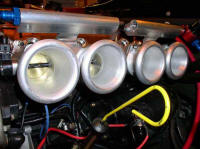
 |
Tuning ITBs - ITB Sizing | |
|
|
Up
|
At lower engine RPMs, even correctly sized ITBs behave like really oversized throttles. It is typical for the engine's I have worked on to idle with a MAP of about 50% - 55%. This is much higher than what you would see with a single throttle body which typically has a MAP around 30% at idle. The reasons for this higher idle MAP include the lack of an idle air circuit within the throttle body. The aftermarket throttles must be set slightly open, like a carburetor to set the warm idle speed. This creates a relatively large vacuum leak at idle resulting in the high idle MAP. Engines that come with ITBs from the factory usually have a better designed idle air circuit and the idle MAP on these engines can be very close to the "normal" idle MAP of about 30%. Cam selection also plays a large role in the idle map. Longer duration cams with larger amounts of overlap will have an idle MAP noticeably higher than less aggressive cams. The 2.3L M10 engine I tuned with the 316 degree cam had an idle MAP about 10% higher than the 2.0L engine with a cam closer to a 284 degree duration. All normal driving occurs at a MAP of 80% or greater, with highway cruising at a MAP of 85% to 90%. Acceleration occurs mainly in the 90% to 100% MAP region. What this all means to tuning for daily driving is that you spend most of your time at less than 20% throttle unless you are accelerating, and with a MAP of greater than 80%. Operating in these regions presents some challenges to tuning. The dynamic range of the TPS and MAP signals are both very small compared to similar ranges seen with a single throttle body. |
|||||||||||
This site was last updated 05/09/10